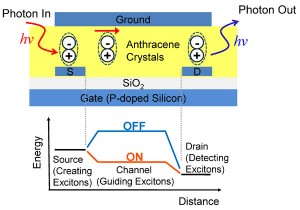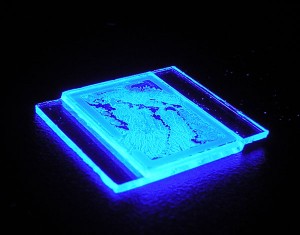Organic Excitonic Transistors
Excitons, bound pairs of electrons and holes, mediate the interconversion of charges and photons and thus can be used for an efficient interconnect between electronic circuits and optical communication. The ability to guide excitons in space can lead to an excitonic switch that directly routes an optical signal. Recently, High et al. demonstrated an excitonic transistor using indirect excitons formed in AlGaAs/GaAs coupled quantum wells at a temperature of 1.4K [1]. The much larger binding energy of excitons in organic semiconductors could enable excitonic transistors at room temperature. Furthermore, by exploiting spin-disallowed transitions in organic materials, room-temperature excitons can last up to milliseconds, more than sufficient to enable exciton propagation over large distances and the operation of sample circuits.
In this work we aim to demonstrate an exciton transistor based on organic semiconductors that can operate at room temperature. Excitons have a dipole moment with a defined electron-hole spacing. The exciton energy can be controlled by coupling external electric fields with the exciton dipole moment. We propose to guide excitons using the energy gradient determined by external electric fields (See Figure 1). In order for us to operate this optical switch, excitons are required to diffuse at least roughly over the wavelength of light to overcome the diffraction limit. A triplet exciton, an excited state with a total spin of 1, has a long diffusion length since its recombination is disallowed by spin. Indeed, anthracene crystals show a triplet diffusion length of ~20µm at room temperature. We grow anthracene crystals inside a cavity by a melting process, expecting to achieve a uniform and defect-free crystal for efficient exciton diffusion. We expect that this work will open a promising route toward the spatial manipulation of excitons in organic semiconductors.
- Figure 1: The device structure of the organic excitonic transistor and its energy profile under the operating condition. We control excitonic fluxes by modulating the gate bias and, thus, the potential barrier. The top electrode is transparent, enabling the exciton creation and detection by incoming and outgoing photons.
- Figure 2: An anthracene crystal grown inside a cavity sandwiched between two glass substrates. The sample is luminescing blue light under UV excitation.
References
- A.A. High, E.E. Novitskaya, L.V. Butov, M. Hanson, and A.C. Gossard, “Control of exciton fluxes in an excitonic integrated circuit,” Science, vol. 321, pp. 229-231, July 2008. [↩]
- D.F. Williams and J. Adolph, “Diffusion length of triplet excitons in anthracene crystals,” The Journal of Chemical Physics, vol. 46, pp. 4252-4254, June 1967.

